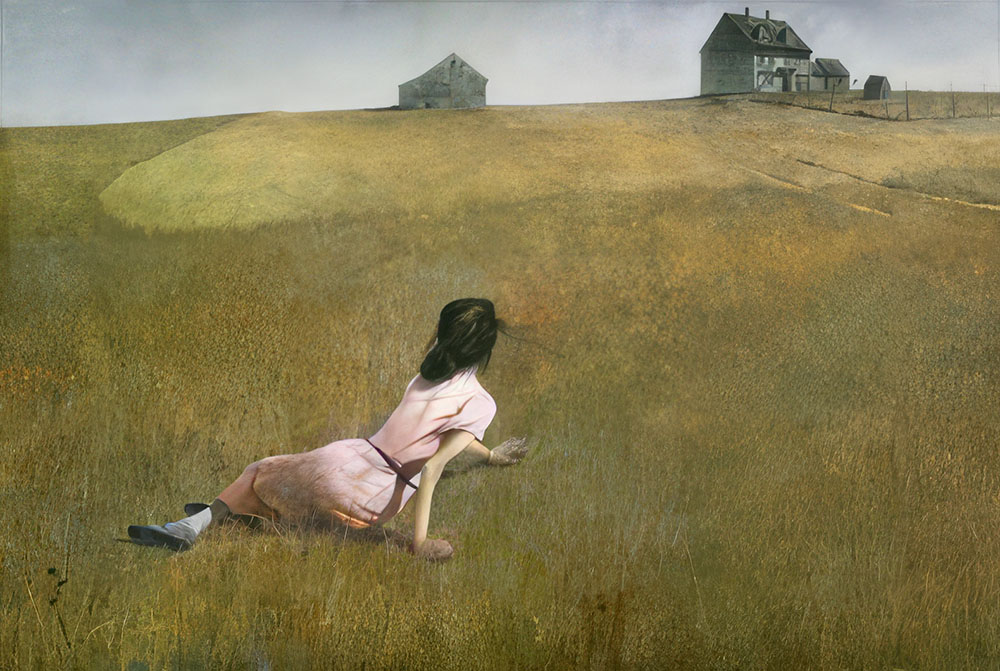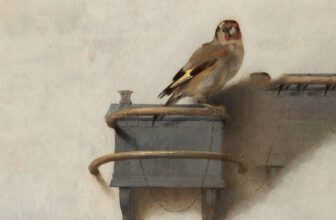
The Meaning of Christina’s World Painting
“Christina’s World,” painted in 1948 by the American painter Andrew Wyeth, is more than just an iconic artwork , it is a deeply introspective and emotionally resonant image that has captivated audiences for generations. Its haunting tranquility, mysterious figure, and expansive landscape beg the viewer to look closer, to question, and to feel.
Housed today in the Museum of Modern Art (MoMA) in New York City, “Christina’s World” is regarded as one of the most enduring and enigmatic works of American art. This post offers a comprehensive look into the painting’s creation, the identity of its subject, its artistic style, symbolism, and the emotional and psychological layers that have solidified its place in art history.
The Subject: Who Is Christina?
At the heart of “Christina’s World” is a woman in a pink dress, lying in a vast field and gazing longingly at a gray farmhouse in the distance. The woman is Christina Olson, a real person who lived near Wyeth’s summer home in Cushing, Maine.
Christina Olson (1893–1968) suffered from a degenerative muscular disorder that left her unable to walk from a young age. Though doctors believed she had polio, modern speculations suggest she may have had Charcot-Marie-Tooth disease or another form of neuromuscular atrophy. Refusing to use a wheelchair, Christina chose instead to crawl across the ground using her arms and upper body , a powerful act of autonomy and resilience.
Andrew Wyeth was fascinated by Christina’s quiet strength and independent spirit. He formed a close friendship with her and her brother Alvaro Olson during his frequent visits to Maine. Over time, the Olson farmhouse became one of Wyeth’s most significant sources of inspiration.
The Making of “Christina’s World”: How the Painting Came to Life
Andrew Wyeth painted “Christina’s World” in 1948, combining realistic technique with profound emotional undercurrents. Despite Christina being the painting’s subject, the figure in the field was not painted directly from life. Wyeth used Christina Olson’s spirit and condition as inspiration, but the physical model for the woman was Wyeth’s wife, Betsy Wyeth, who posed for the body.
The painting was completed in tempera on panel, a demanding medium that requires great precision. Tempera paint , made by mixing pigment with egg yolk , was Wyeth’s preferred medium and allowed him to achieve the meticulous detail and textural subtlety seen in his work.
The landscape depicted is the actual terrain surrounding the Olson House in Cushing. Wyeth painstakingly observed and captured the dry grass, the pale light, the dilapidated barn, and the house , infusing these details with emotional resonance. Though the landscape is based on reality, the composition is imagined. Christina never actually lay in that precise spot in real life , the scene is a synthesis of observation, memory, and emotion.
What Is Happening in “Christina’s World”?
The painting portrays a woman lying in a field with her back turned toward us, her body partially propped up as she gazes toward a distant farmhouse. Her arms are thin, her body vulnerable, but her posture conveys intense focus and resolve.
There is an unsettling silence to the scene. Is she resting? Crawling? Waiting? Is she resigned, or determined? Wyeth deliberately leaves these questions unanswered, heightening the psychological complexity of the work.
The vast, empty field around Christina suggests both isolation and perseverance. The farmhouse is simultaneously close and far, within sight but out of reach. The lack of visible pathways , no road, no worn trail , emphasizes her physical limitation and the effort required to reach her home. It also symbolizes the broader human struggle to reach one’s desires or goals despite personal hardship.
Symbolism and Meaning: What Does “Christina’s World” Represent?
“Christina’s World” is often seen as a poignant symbol of human endurance, independence, and vulnerability. Beneath its calm surface lies a rich web of meanings, both personal and universal.
Isolation and Distance
The space between Christina and the house is a metaphor for emotional and physical distance. The viewer, like Christina, remains apart from the structure , observing, yearning, reaching. It reflects the isolation many feel in moments of limitation or despair.Determination and Resilience
Christina’s choice to crawl instead of using a wheelchair is a declaration of dignity and self-reliance. Her body may be frail, but her will is unwavering. The painting honors that quiet defiance.Psychological Landscape
Many scholars interpret the field and farmhouse as a representation of Christina’s inner world , a blend of memory, desire, and reality. The house becomes a symbol of identity, family, and perhaps the unattainable. The painting invites the viewer to step into Christina’s mind, to feel what she feels.The American Dream Turned Inward
Painted in the aftermath of World War II, during a time when optimism and suburban expansion were on the rise, “Christina’s World” offers a counter-narrative. Instead of bustling cities or thriving towns, we see solitude, aging rural buildings, and a woman left behind. Wyeth critiques the mythology of American progress by focusing on the forgotten and marginalized.Mortality and Stillness
The muted colors and barren landscape suggest the passage of time and the inevitability of mortality. The stillness of the figure evokes both life and death , she could be crawling, or she could be lying still forever.
What Type of Art Is “Christina’s World”?
Andrew Wyeth is often associated with realism, particularly American realism, but his work is also infused with emotional and symbolic depth more often linked to magic realism.
While realist in its meticulous depiction of surfaces, textures, and natural light, “Christina’s World” transcends simple representation. The scene is not a snapshot of life but a composition carefully constructed to evoke emotion and meaning. This tension between exactitude and imagination is what gives Wyeth’s realism its unique power.
Wyeth’s work stood in contrast to the dominant movements of his time. In the 1940s, abstract expressionism was beginning to emerge, championed by artists like Jackson Pollock and Mark Rothko. Wyeth, by contrast, remained committed to representational painting, often dismissed by critics as sentimental or old-fashioned. Yet, in recent decades, critical appreciation for Wyeth’s emotional realism has grown significantly.
Critical Reception: Then and Now
When Wyeth first presented “Christina’s World,” the painting received mixed reviews. Many in the contemporary art world viewed Wyeth’s style as regressive. However, Alfred Barr, the founding director of MoMA, recognized its quiet power and purchased it for the museum’s permanent collection , a pivotal moment in the painting’s legacy.
Over time, “Christina’s World” has become one of the most beloved and widely recognized American paintings. It appears in textbooks, films, and popular culture, often symbolizing solitude, strength, and the human condition.
Today, Wyeth is often seen as a bridge between American regionalism and more psychologically complex styles of realism. His ability to convey profound emotional truths through familiar rural imagery has earned him a renewed and more appreciative audience in the 21st century.
Where Is “Christina’s World” Now?
The original painting of “Christina’s World” resides in the permanent collection of the Museum of Modern Art (MoMA) in New York City, where it has been since shortly after its completion in 1948. It is one of MoMA’s most visited and admired works, holding its place alongside masterpieces of modernism and abstraction.
Visitors often spend extended time in front of the painting, drawn in by its quiet mystery and emotional resonance. Despite its small size (approximately 2.5 feet by 4 feet), the painting’s psychological scale feels vast.
Additionally, the Olson House in Cushing, Maine, where Christina lived and which served as the model for the farmhouse, has been preserved and is now a National Historic Landmark. It is managed by the Farnsworth Art Museum and is open to visitors who want to walk the same ground that inspired one of America’s most iconic artworks.
Cultural Impact
“Christina’s World” has entered the people’s vision in a way few works of art manage to do. It has been referenced, parodied, and reimagined in various media , from literature and film to music videos and advertisements.
The painting continues to resonate in contemporary discourse because it touches on universal themes: longing, resilience, isolation, and the unspoken inner life. In an age of hyperconnectivity and surface-level interactions, Wyeth’s focus on the inward, the silent, and the emotionally ambiguous feels more relevant than ever.
Andrew Wyeth himself described his approach not as nostalgic, but as deeply personal. “I prefer winter and fall, when you feel the bone structure in the landscape,” he once said. “Something waits beneath it; the whole story doesn’t show.” That idea , that something waits beneath the surface , is perhaps the ultimate key to understanding “Christina’s World.”
The Quiet Power of Stillness
“Christina’s World” endures not because it provides answers, but because it invites us into a world of quiet mystery and psychological depth. Through a single figure, turned away from us, Wyeth captures the essence of longing, perseverance, and the intimate human experience.
In Christina, we see ourselves , our fragility, our strength, our unspoken desires. And in the field that stretches endlessly before her, we find the space to reflect on our own journeys, our own unreachable houses on the hill.
Andrew Wyeth painted what he knew, but imbued it with what he felt. And that fusion of the familiar and the emotional , of the real and the imagined , is what makes “Christina’s World” not just a painting, but a mirror for the soul.




